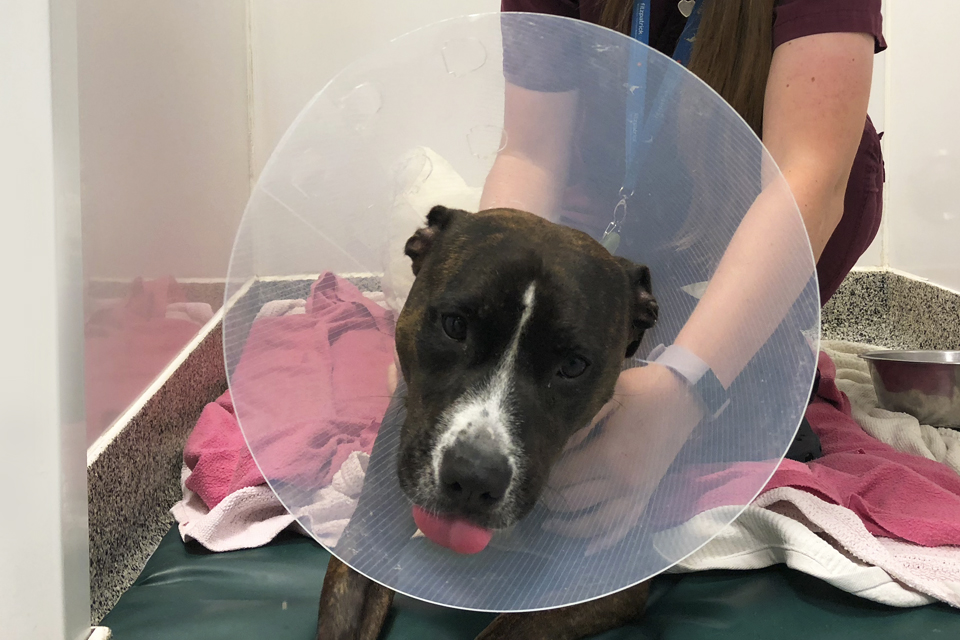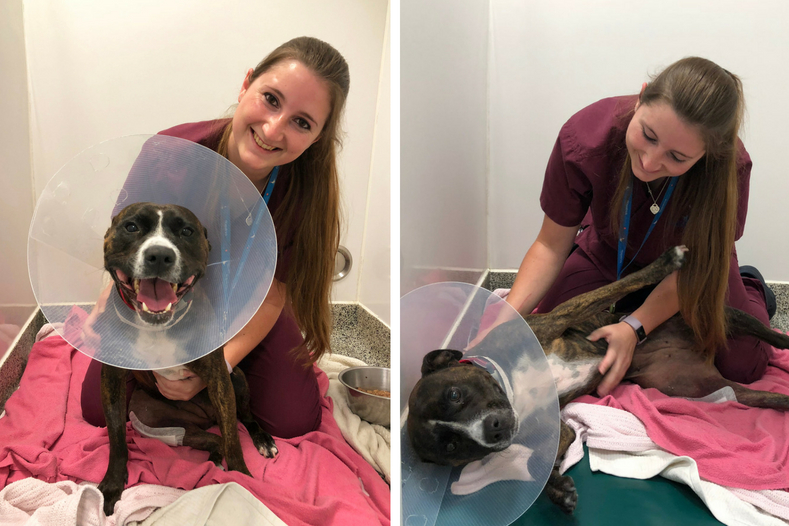Bridie’s story – bilateral patellar luxation

Bridie is a sweet-natured two-year-old Staffordshire Bull Terrier cross from Hampshire, who was referred to Fitzpatrick Referrals by her vet after she began showing signs of discomfort in her left hind leg.
Bridie had already been diagnosed with patellar luxation (dislocating knee cap) in her right hind leg after she began holding the limb off the ground occasionally. Her family restricted her exercise for a few months but now noticed she was repeatedly stretching out her left pelvic limb.

Surgical Registrar Susan Murphy saw Bridie and her family for an initial consultation earlier this year. On clinical examination, Susan found both patellae were unstable and spontaneously dislocated with minimal flexion of Bridie’s stifle.
Both were considered to be high grade 2 medial patellar luxation and following x-rays, Susan recommended Bridie for staged surgical procedures on both patellae.
Susan performed the surgery on Bridie’s left patellar in February, which involved a bloc recession trochleoplasty in addition to a tibial tuberosity lateralisation and lateral imbrication.
Bridie returned home to recover on strict crate rest and limited lead walks. At her 6-week check-up, Susan found her knee was still luxating – an occasional complication where the patella still dislocates – so she had revision surgery. Once fully recovered, she returned to the practice in August and Susan performed surgery on her right patella.
Bridie’s mum said:
Our treatment at Fitzpatrick Referrals has been fantastic, all of the staff are wonderful. Susan has kept us up-to-date with Bridie’s progress and explained clearly the procedures she was having.
Bridie has been a delight to look after. She is such an affectionate dog and all our patient care staff have grown very fond of her during her stay.

Bridie enjoying the attention of ward auxiliary Becky, whilst recovering in her kennel after her second surgery at Fitzpatrick Referrals Orthopaedics and Neurology.
Susan answers FAQs about patellar luxation
What is the grading system for patellar luxation?
The grading system for patellar luxation is based on how mobile the knee cap is relative to the groove at the base of the femur.
- Grade 1: A knee cap that can be luxating with manual pressure but is otherwise is within the groove.
- Grade 2: The knee cap spontaneously luxates, is typically associated with a skipping lameness when the knee cap moves.
- Grade 3: The knee cap is permanently luxated but can be manually replaced in the groove.
- Grade 4: The knee cap is permanently luxated and cannot be manually replaced in the groove.
Does a patellar luxation diagnosis always need surgery?
Surgery is strongly advised for grade 3 and 4 patellar luxation. For grade 2 medial patellar, luxation only dogs exhibiting significant clinical signs – i.e. a lameness, are recommended for surgical management. Surgery is never advised for a grade 1.
Could delaying a referral for patellar luxation, do more damage to my dog?
Patellar luxation when severe can cause skeletal abnormalities such as bowing of the femur or tibia. In milder cases, we often see cartilage loss from the underside of the patella and/or the surface of the grove as the cartilage is physically abraded from the patella slipping out of the groove. Patients with medial patellar luxation are also more prone to developing cranial cruciate ligament disease. As with most things, if the condition is causing a clinical problem then the earlier it is addressed the better it is for the patient in both the short and the longer-term.
